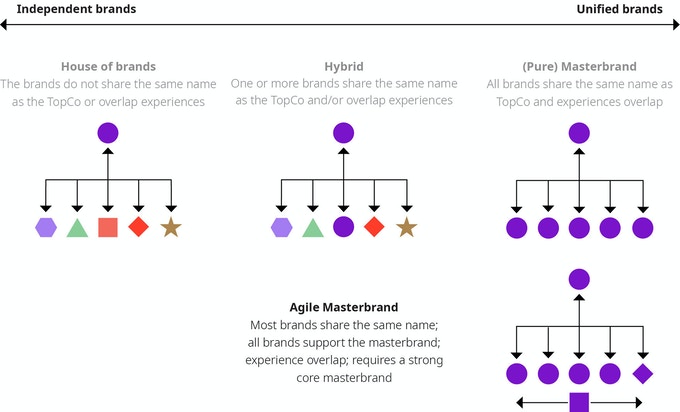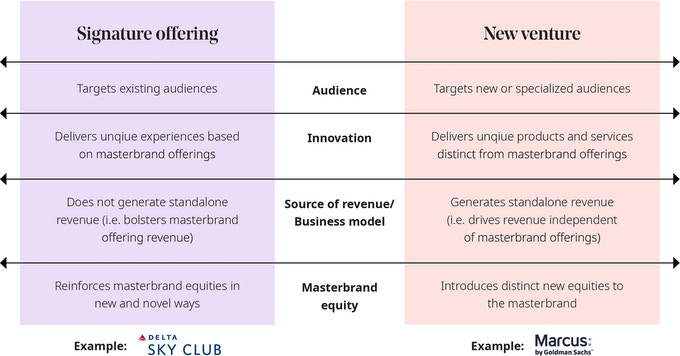
Growth is an essential part of business, and the way a company manages its brand(s) can have a significant impact on the type of growth it will experience. Vice versa, how a company plans to grow is very important in choosing the correct brand management model.
For example, if your expectation is not incremental, slow-and-steady, year-over-year growth, and you are looking for something more explosive to jumpstart the business, then an agile masterbrand model might be more suitable for your business than a House of Brands model.
A masterbrand strategy has been a traditionally efficient way to generate value. Now, leading companies looking to accelerate growth are using a new model – the agile masterbrand – that preserves the best benefits of the masterbrand model while creating new revenue streams more effectively in today’s markets.
Consulting firm Lippincott recently explored the idea of an agile masterbrand model in more depth, and Brandingmag had the pleasure of picking the mind of Nital Patel, the lead strategist of this report. Nital is a senior partner on brand strategy at Lippincott and has almost two decades of experience working with global brands across industries on brand architecture, portfolio assessment, and positioning.
Brandingmag: How has digital transformation affected brand architecture?
 Nital Patel: Digital transformation has made it easier for organizations chasing growth to create new brands. Advancements in AI and data analytics, for example, make targeting specific consumers easier and more common than ever before (e.g., the countless niche direct-to-consumer brands). The cost of brand building in today’s digital-first market has also dropped with smarter ways to advertise digitally and to build brands through social media – making it cheaper and quicker to build meaningful new brands.
Nital Patel: Digital transformation has made it easier for organizations chasing growth to create new brands. Advancements in AI and data analytics, for example, make targeting specific consumers easier and more common than ever before (e.g., the countless niche direct-to-consumer brands). The cost of brand building in today’s digital-first market has also dropped with smarter ways to advertise digitally and to build brands through social media – making it cheaper and quicker to build meaningful new brands.
These shifts are all conducive to organizations building more brands, rather than fewer, which presents both opportunities and challenges to marketing and brand practitioners when it comes to how they manage their brand architecture systems.
Bm: What is the difference between the masterbrand and the overbrand models?
NP: Under a traditional masterbrand model, all offerings and experiences share the same brand name and visual identity. This culminates in a much more seamless and unified experience for customers but also presents numerous efficiencies and advantages for organizations – fewer brands to manage means lower marketing costs and greater focus and impact when it comes to brand building. GE is a great example of a masterbrand model with all services – from aviation to healthcare – delivered under the GE masterbrand.

In contrast, a House of Brands model is characterized by a portfolio of independent brands. The brands do not share the same name or visual identity as the parent brand, which provides organizations with the flexibility to go after new audiences or launch products and services in new areas where the parent brand may not have credible equities. Procter & Gamble adopts a House of Brands approach, creating a portfolio of independent brands that serve different audiences across multiple consumer goods categories. While this approach provides the benefit of flexibility, the lack of brand connection across the portfolio can stand in the way of effective brand building given equities aren’t being transferred back to the parent brand. Managing multiple brands under this approach can also be more costly and resource intensive.
Bm: What about the ‘agile’ masterbrand model? How is this different from the traditional one?
NP: The agile masterbrand model evolves the way an organization manages a masterbrand system by providing more flexibility to pursue growth. It enables organizations to target new audiences, launch new offerings, innovate in untapped areas – all while continuing to drive equity back to the parent brand. The introduction of new ventures and signature offerings into the architecture unlocks opportunities to launch new branded offerings that are importantly connected to the parent brand through brand elements such as name, visual identity, and experience. The notion of active management also safeguards against potential brand proliferation. (explained further in Q5)
Bm: Why is the agile model needed in today’s market? Who needs it and when?
NP: The agile model is the solution for growth-oriented organizations looking to jump-start growth while continuing to build their parent brand. Companies of all shapes and sizes are increasingly being challenged by disruptors across industries. Having the strategic flexibility to launch a new branded offering to compete against these threats is a huge plus – particularly if it’s managed in a way that ultimately works to build the parent brand.
Determining when an agile model might be right ultimately comes down to an organization’s growth strategy and objectives. If growth is likely to be unlocked via targeting new audiences, launching disruptive offerings, creating innovative experiences or services, or new sources of revenue or business models, an agile model may be an effective strategy to adopt. (covered in more detail under Q8).
Bm: What is ‘brand proliferation’ and how does the agile masterbrand model prevent it?
NP: Brand proliferation is when you end up having too many brands within your organization to the point where you can’t effectively manage them all. With brand proliferation, the amount of brands you have exceeds the resources you have to effectively market and grow each brand, so you end up seeing some brands become prioritized while others fall to the wayside. In extreme cases, you can see all brands in the portfolio suffer because none of them have the right amount of support to be successful.
An agile masterbrand model actively protects against proliferation. Under this approach, specific goals are set around the equities that you hope to transfer over time to the master brand. And over time, as the master brand equities expand, the newly created brand is absorbed back into the master brand, so you’re able to avoid ever having too many brands out on their own that you need support. Organizations will generally bring their branded offerings closer to the master brand when the audiences of the offering are no longer distinct from the master brand’s audience, the offering is no longer innovative in the competitive landscape, or when the desired brand equities have been transferred back to the master brand.
Bm: The agile masterbrand model seems highly similar to the hybrid model; what’s the difference?
NP: There are two key factors that distinguish an agile master brand model from a hybrid model: first, the goal of the individual brands under the parent brand, and second, the relationship between the individual brands the parent brand. In an agile master brand model, all of the brands under the parent brand are connected in some way back to the parent brand, be it through an explicit endorsement (a blank company) or an implicit link (such as a shared experience). Each of these brands also has a singular goal that unites them – they all were created to strengthen the master brand. That is their number one goal, the reason they exist.
In a hybrid model, on the other hand, you only have a few brands that are directly connected back to the parent brand – the other brands are purposefully separate from the parent brand, either due to equity misalignment, regulatory conflict, or other reasons. This also means that each brand under the parent brand likely has different goals. Some of the brands may strengthen the parent brand, but some may not. Some may actively (and purposefully) steal market share away from the parent brand (think of Instagram and Facebook).
Bm: What is the difference between ‘signature offerings’ and ‘new ventures’, and how is ‘active brand management’ connected to them?
NP: New ventures are a unique product or service that serves a distinct growth role. They are closely connected to the master brand through experience and design but exist as a separate brand that strategically drives stand-alone revenue. Their novelty lies in how they are used to introduce new equities that enable the master brand to pivot into new growth areas.
Alexa from Amazon is a great example of a new venture. As an AI-powered digital assistant with its own ecosystem of products, Alexa helped Amazon tap into new audiences while building innovative equities in the Amazon brand – driven by its deep integration across the Amazon ecosystem.
In contrast, signature offerings are innovative and differentiated offerings, whose value transcends any specific master brand product or service. They may comprise of a discrete product, service, feature, or experience, and unlike a new venture, they do not drive stand-alone revenue. The revenue they generate is either incremental and dependent on the sale of a core master brand offering.

While a signature offering can introduce new equities to the master brand, their unique value comes from amplifying existing master brand equities. A good example of a signature offering is Delta Sky Club, a branded airport club experience that builds on the core offering of their flights and reinforces Delta as the airline of choice for premium travel.
The success of a new venture or signature offering is closely tied to ‘active management’ – the other key feature of an agile masterbrand approach. Active management is based on the idea that each new venture or signature offering has a strategic role to build the master brand, and the success in accomplishing that role impacts how the new venture or signature offering is managed over time. For example, a new venture may be tasked with building new equities for the master brand; and as those new equities are established, the new venture is brought closer to the master brand over time.
Bm: How can brands know when the agile masterbrand model is suitable for them and where should they start with it?
NP: The agile masterbrand model is all about growth: If you are looking to innovate, launch new products, new services, or try out a new business model, the agile masterbrand can help your brand expand its offerings without the risk of brand proliferation.
You may want to ask yourself: How does your organization plan to grow over the next 5 to 10 years? Are you looking for incremental, slow, and steady growth year after year or are you looking for a big change – something to jumpstart growth and yield large returns? If you are looking for steady, more conservative growth, an agile masterbrand may not be right for you. But if you are really looking for a step change, the agile masterbrand model can help support your growth objectives.
When it comes to where to start, if you know you’re looking for step-change growth, the next thing to do is to dive deeper: Start looking into what offerings are being developed and launched, inventory and assess your current branded offerings and architecture, then start putting the pieces of the puzzle together to think about what new offerings in the pipeline could be a new venture or a signature offering, or what existing offerings could be brought closer to the parent brand to make way for the new offerings. From there, build on that knowledge, to formalize both the agile masterbrand strategy as well as the criteria around both new ventures and signature offerings unique to your masterbrand and business strategy.
Cover image source: Brayden Law